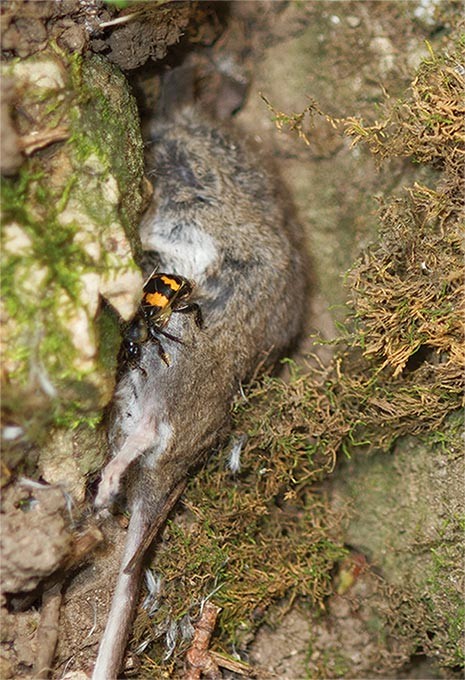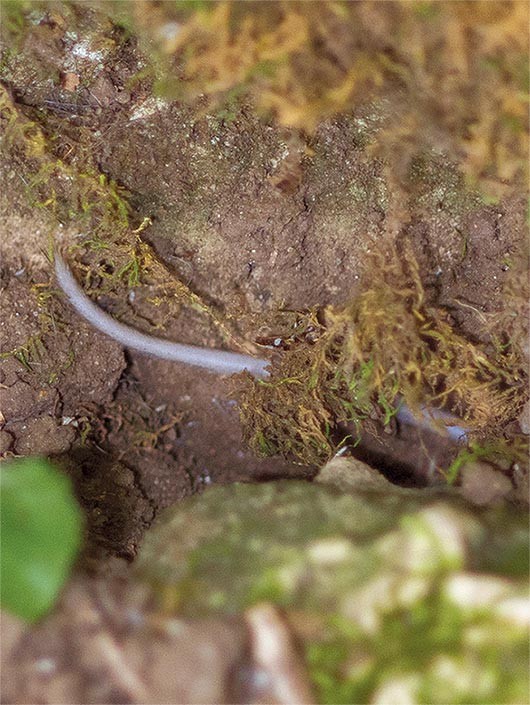A regular chore of mine is to dispose of the mice and moles trapped in our home. I place them on a 4 x 5-foot patch of dirt and rock – which I have named the grave site – beside my woodshed. There, they typically disappear overnight, taken, I had assumed, by our resident barred owl, or perhaps a skunk, raccoon, or bobcat.
Then one day last July, as I was stacking my wood for the coming winter, I noticed a small black and orange beetle around one of the disposed mice. Fascinated, I watched for over an hour as a tomentose beetle (Nicrophorus tomentosus) dug a trench alongside the mouse and ever so slowly rolled the mouse into it. Another beetle arrived and went under the mouse and removed more soil. If I disturbed them, the beetles would bury themselves quickly, then resume work in a matter of minutes once they felt safe. The carcass was gradually lowered into the ground until it was interred.
Throughout the summer I watched nine additional deer mice or white-footed mice being buried or dragged into crevices and covered in this small area. After hours of observation, I realized that the tomentose beetles were not alone in using this grave site; I also saw roundneck sexton beetles (Nicrophorus orbicollis) at work.
Burying beetles are members of the Silphidae family and are also called “carrion” or “sexton” beetles; it’s a large group: there are about 100 species of Nicrophorus alone. Within this genus, a tomentose beetle is identifiable by the dense yellow pubescence on the dorsal front of the thorax. Its club antennae, which double as a nose, are used for sensing vertebrate carcasses; if the male finds a carcass first, he sends out pheromones to attract a female. The carcass plays an essential role in the breeding process, so the pair must coordinate carefully.
The beetle or beetles first test the soil to determine if it’s suitable for excavation. They then turn over on their backs and squeeze under the carcass. Using their six legs in a series of leg presses, they leverage the body, moving it ever so slightly toward the chosen burial site.
Once buried, they strip the animal of its fur with their mandibles and drag this material to the surface. The skinned carcass is then shaped into a ball and an anal secretion is spread over it to retard decomposition. The female beetle lays her eggs randomly in the nearby soil, making it more difficult for predators to locate and destroy them. The eggs hatch in a few days and the larvae feed on the carcass. Tomentose beetle larvae largely develop on their own, while roundneck sexton beetle parents provide their larvae with protection and food until the point of pupation. Ants are key predators during this period of life.
Flies are quick to lay their eggs on the carcass before it’s buried, which can compromise it. Burying beetles combat these dipteran competitors by destroying their eggs and larvae, and they get some help from phoretic mites (Uroobovella nova) that are reported to pierce and eat the fly eggs and freshly hatched maggots. It’s a two-way relationship: The mites cling to the beetle’s body for transportation and reproduce in the beetles’ brood chamber.
It’s generally accepted that this is a commensal relationship that benefits both mites and beetles, though there is some suggestion that the mites might, in some cases, eat Nicrophorus eggs and larvae.
The burying beetles made for an interesting summer. And in my research I learned that these beetles, like nearly all animals, are not immune from the effects of habitat alterations and chemical toxins. The American burying beetle (Nicrophorus americanus), for example, is now a federally endangered species; once occurring over the entire eastern United States, it is today found in only six states. One must realize the value of all living wildlife species, from the largest predator to the rarely seen insect in the soil, and their contributions to the natural world.






Discussion *